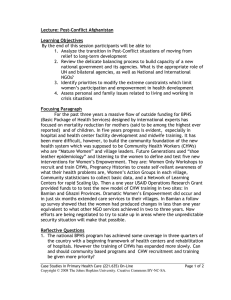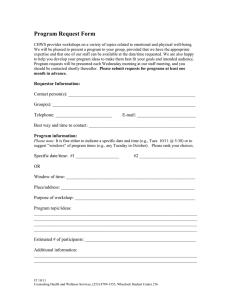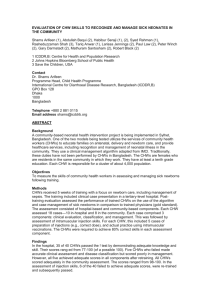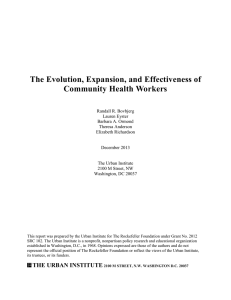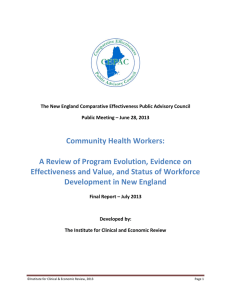An Agile and Accessible Adaptation of Bayesian Inference to Medical
advertisement
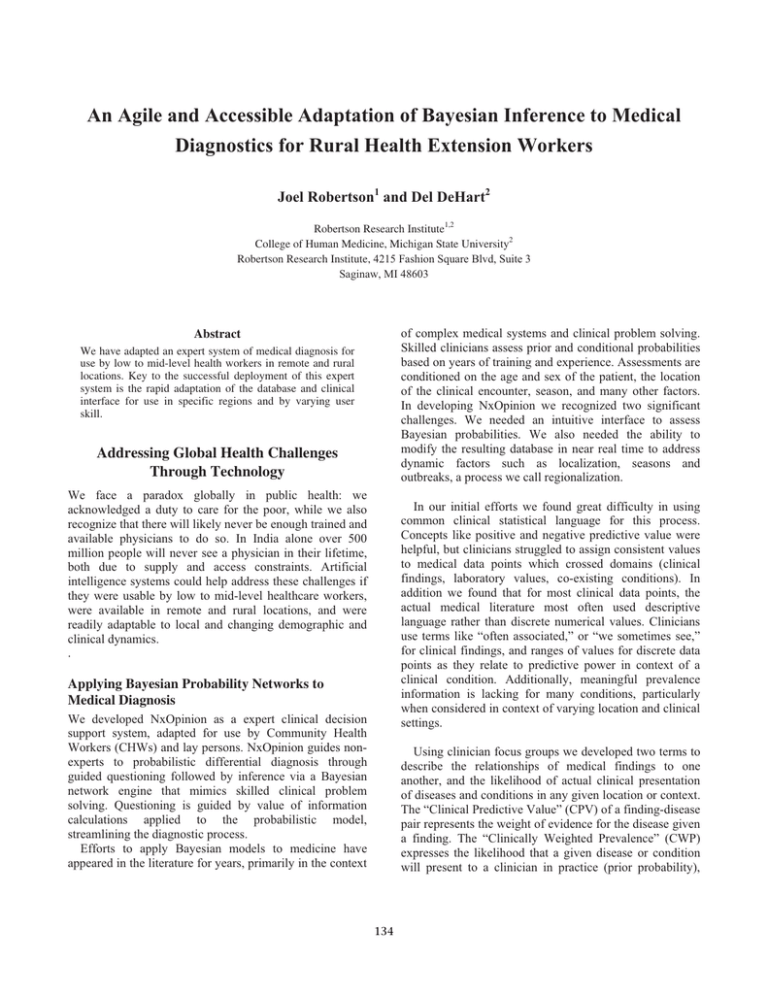
An Agile and Accessible Adaptation of Bayesian Inference to Medical Diagnostics for Rural Health Extension Workers Joel Robertson1 and Del DeHart2 Robertson Research Institute1,2 College of Human Medicine, Michigan State University2 Robertson Research Institute, 4215 Fashion Square Blvd, Suite 3 Saginaw, MI 48603 of complex medical systems and clinical problem solving. Skilled clinicians assess prior and conditional probabilities based on years of training and experience. Assessments are conditioned on the age and sex of the patient, the location of the clinical encounter, season, and many other factors. In developing NxOpinion we recognized two significant challenges. We needed an intuitive interface to assess Bayesian probabilities. We also needed the ability to modify the resulting database in near real time to address dynamic factors such as localization, seasons and outbreaks, a process we call regionalization. Abstract We have adapted an expert system of medical diagnosis for use by low to mid-level health workers in remote and rural locations. Key to the successful deployment of this expert system is the rapid adaptation of the database and clinical interface for use in specific regions and by varying user skill. Addressing Global Health Challenges Through Technology We face a paradox globally in public health: we acknowledged a duty to care for the poor, while we also recognize that there will likely never be enough trained and available physicians to do so. In India alone over 500 million people will never see a physician in their lifetime, both due to supply and access constraints. Artificial intelligence systems could help address these challenges if they were usable by low to mid-level healthcare workers, were available in remote and rural locations, and were readily adaptable to local and changing demographic and clinical dynamics. . In our initial efforts we found great difficulty in using common clinical statistical language for this process. Concepts like positive and negative predictive value were helpful, but clinicians struggled to assign consistent values to medical data points which crossed domains (clinical findings, laboratory values, co-existing conditions). In addition we found that for most clinical data points, the actual medical literature most often used descriptive language rather than discrete numerical values. Clinicians use terms like “often associated,” or “we sometimes see,” for clinical findings, and ranges of values for discrete data points as they relate to predictive power in context of a clinical condition. Additionally, meaningful prevalence information is lacking for many conditions, particularly when considered in context of varying location and clinical settings. Applying Bayesian Probability Networks to Medical Diagnosis We developed NxOpinion as a expert clinical decision support system, adapted for use by Community Health Workers (CHWs) and lay persons. NxOpinion guides nonexperts to probabilistic differential diagnosis through guided questioning followed by inference via a Bayesian network engine that mimics skilled clinical problem solving. Questioning is guided by value of information calculations applied to the probabilistic model, streamlining the diagnostic process. Efforts to apply Bayesian models to medicine have appeared in the literature for years, primarily in the context Using clinician focus groups we developed two terms to describe the relationships of medical findings to one another, and the likelihood of actual clinical presentation of diseases and conditions in any given location or context. The “Clinical Predictive Value” (CPV) of a finding-disease pair represents the weight of evidence for the disease given a finding. The “Clinically Weighted Prevalence” (CWP) expresses the likelihood that a given disease or condition will present to a clinician in practice (prior probability), 134 and varies dynamically based on multiple factors, including age, sex, location, season and pre-existing conditions. We divided each of these concepts into meaningful ranges or “buckets” expressed in clinical language. Five buckets were used for CPVs (rarely, occasionally, often, typically and consistently associated), and numerical values were assigned to each bucket. A similar approach was used for CWPs, though seven buckets were used. For CWPs, key data points were sought where available (WHO Global Health Atlas; CDC Data and Statistics) as starting points for ranking of diseases and conditions. Using these concepts, expert clinician panels were able to rapidly translate clinical knowledge into data points accessible to Bayesian inference, combining the best available quantitative information with the qualitative expertise of physicians. methods. CHW diagnoses were compared to the diagnosis of a physician evaluating the same patient immediately after the CHW. In an interim analysis of the first 514 (of >1100 accrued patients) agreement with physician diagnosis improved from 55% (262 patients evaluated using traditional methods) to 83% (252 patients evaluated with NxOpinion). Also, the use of NxOpinion greatly increased the amount of patient history information collected (1,836% more) and number of findings recorded for the presenting condition (59% more). Future Directions NxOpinion was initially developed as a stand-alone thin client application. We have completed development of a web services layer and a feature phone application for remote data gathering, adherence monitoring and diagnostic decision support for CHWs. Current projects are ongoing in Kenya, Mozambique and India. We developed the medical database by expert clinical review of the literature, assigning a CPV to each clinical predictor (a clinical finding, medical history fact, laboratory value or diagnostic test result) in context of each disease or condition to which it was associated. Expert panels next assigned a CWP value to each disease or condition, often varying the CWP within a disease or condition based upon secondary demographical or clinical factors (pregnancy in women, croup in children, or opportunistic infections in AIDS, for example). The database currently includes over 1,000 diseases mapped to over 6,000 discrete findings (clinical predictors), allowing for fine-grained data capture and analysis. References Anand, V., Biondich, P. G., Liu, G., Rosenman, M., Downs, S. M., 2004. Child Health Improvement through Computer Automation: the CHICA system, Stud Health Technol Inform 107(Pt 1): 187-91. Berger, S. A., and Blackman, U. 1995. A Computer Program for Diagnosing and Teaching Geographic Medicine, Journal of Travel Med. 2, (3): 199-203. Lucas, P. J. F., de Bruijn, N. C., Schurink, K., Hoepelman, I. M. 2000. A Probabilistic and decision-theoretic approach to the management of infectious disease at the ICU, Artificial Intelligence in Medicine 19(3): 251–279. In order to address the dynamic nature of many medical conditions, and variance by location, we developed a rapid regionalization process. Key clinical predictors can be identified based upon CPV values, and can be “translated” into local terminologies. For example, in adapting NxOpinion for use in Andhra Pradesh, India we used the term “frequent motions” for the term “diarrhea” in our database. Miller, R. A., McNeil, M. A., Challinor, S. M., Masarie, Jr., F. E., and Myers, J. D. 1986. The Internist-1/Quick Medical Reference Project—Status Report, West. J. Med. 145: 816–822. Clinical Usage of NxOpinion Ramnarayan, P., Tomlinson, A., Kulkarni, G., Rao, A., Britto, J. 2004. A Novel Diagnostic Aid (ISABEL): Development and Preliminary Evaluation of Clinical Performance. Medinfo 1091-5. In our project in Andhra Pradesh, expert medical panels were able to “regionalize” NxOpinion in about eight hours for use by local CHWs, including addressing variance in prevalence for the region. Including regional and local medical expert leaders in this regionalization process greatly facilitated the local acceptance of, and enthusiasm for, the project. The regionalization process included addressing appropriate diseases for the location, and assigning CWP values to each. Next, the expert panel reviewed each guided template for appropriate CHW terminologies. Lastly, high value clinical predictors were also reviewed for appropriate terminology. In early in 2009, utilizing seven rural clinics surrounding Hyderabad, we studied the performance of these CHWs equipped with NxOpinion compared to CHWs using existing diagnostic Robertson, J., DeHart, D., Tolle, K., and Heckerman, D., 2009. Healthcare Delivery in Developing Countries: Challenges and Potential Solutions., In The Fourth Paradigm: Data-Intensive Scientific Discovery, ed. T. Hey, S. Tansley and K. Tolle, 65-73. Microsoft Research, Redmond, Washington. 135
